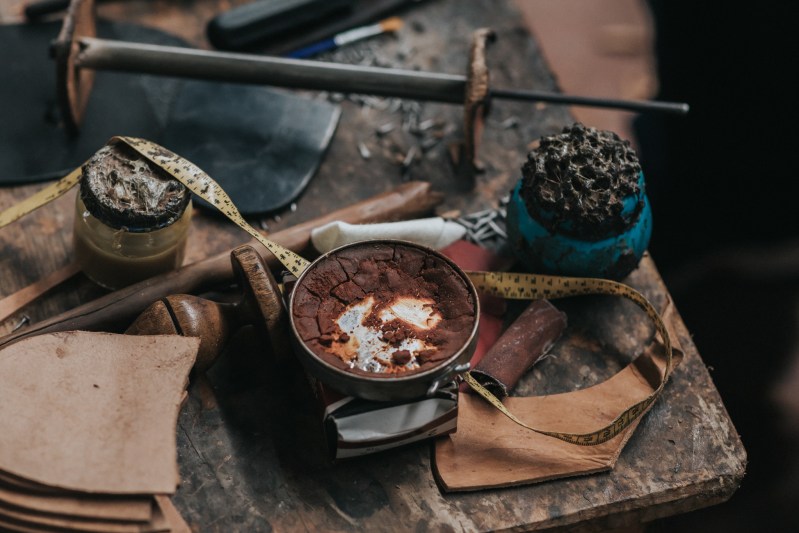Our world today might be faster and more efficient, but there’s a lot we can learn from older generations. How to cook, how to live, and even how to make everyday items that are built to last. I traveled to Guatemala, to a place about an hour and a half outside the country’s capital to find out how Adelante Shoe Co. makes a pair of shoes from scratch. Over two days, its second-generation craftsmen took me through the simple yet laborious process of making a men’s leather cap-toe shoe.
The artisan I worked with, Adrian Gomez, works in a small workshop on a hill with nothing but a plastic chair and small wooden workbench that’s covered in nails, glue, a worn-down knife, and his 25-year old hammer — the same one his father used. He can produce about 10 pairs of shoes per week, but it takes more than just his work to deliver Adelante’s footwear. They work as a team to divide the labor, while still delivering made-to-order shoes in just 10 days.
Better yet, the craftsmen gives customers periodic updates on their shoes’ progress, complete with images, notes, and even videos. When the shoes are completed, a QR code is burned into the sole that links customers to a video of their shoes’ creation. It all points back to the company’s desire to make high-quality items that last. Here’s a look at the work that goes into Adelante shoes.
Cut and Sew
First, workers trace patterns onto pieces of brown tanned leather to form the shoe’s upper. They cut them out and trim them down to size by hand, sharpening their knives after every slice. On the two largest pieces, they create shoelace holes.

The next group of workers stitch the pieces together and give the shoes placeholder shoelaces to keep their shape. They’ll be replaced with real laces at the very end. Craftsmen stitch the style’s signature cap design near the toe of the shoe and pass it off to the more experienced craftsman for next steps.
Onto the Lasts
Next, the uppers are stretched over lasts — plastic and wood shoe molds that Adelante has in each size. The workers use pliers to stretch the leather over the shoe and use small nails to keep it in place, constantly checking that the leather upper is secured in the correct position. Adelante has its lasts specially made because they accommodate up to size 17 and EEEE width. And because they’re custom made, you can even order a different size for each shoe for free.

Gomez gently taps the shoe all over to ensure it fits snugly on the last. This part is one of the most important because the uppers must be positioned just right. Otherwise, the position of the laces would be lopsided and he would have to start over. Gomez can spend more than 30 to 40 minutes adjusting and stretching until he feels the shoes are just right.
The Goodyear Welt
One sign of quality in shoes is a Goodyear Welt. All Adelante shoes have them. Gomez wets the thick leather strip with water to make it flexible. He strips away some of the excess so it will go onto the shoe seamlessly and hammers it into place. He also cuts away wedges of the strip to accommodate the heel and toe.

The shoe then goes to an industrial stitching machine, which uses very thick thread to permanently attach the welt. This welt not only connects the upper to the outsole, but it also means the shoes can be resoled. So, when the bottoms run thin and need to be replaced, they’ll simply replace this strip and the sole that goes with it. After the welt is attached, all the nails that held the upper onto the last are removed.
Crafting the Sole
Gomez places the shoes on a rack so the leather can properly stretch over the last. In the meantime, he starts building the sole, which is simply hardened pieces of leather glued together. He applies the glue with his fingers, wiping the excess onto the glue jar’s lid. He starts with long pieces, which form the top of the sole. Between layers, he places a small metal shank with a 90-degree curve. This keeps the shoes from bending and breaking at the heel. Then he moves to much smaller, curved pieces which will become the heel.

Once the soles have dried, Gomez trims them with his knife and sands them down on a machine. He applies a rubber grip with industrial glue on the bottom of the shoe, then trims the sole again for a seamless look. He uses another industrial stitching machine to attach the outsole to the welt so the shoe is now all in one piece.
Finishing Touches
As a part of his final review, Gomez taps the shoes with his hammer to make sure everything is symmetrical and aligned. He makes sure they’re balanced on all sides and begins to clean and prep the leather for shipment.

He uses a long metal rod to lock into the last and pull it out of the completed shoe. He also replaces the production laces with new ones and leaves them on a rack where they’ll be scanned and shipped. Gomez then writes personal notes to the customer telling them their shoes are ready.
It’s a simple yet painstaking process to create these shoes, but Gomez says it’s very satisfying to send the final product to their customers. He might be using old-school techniques, but it takes a lot of modern technology for Adelante to deliver shoes in just 10 days. It’s thanks in large part to these skilled workers who are keeping their craft alive.


